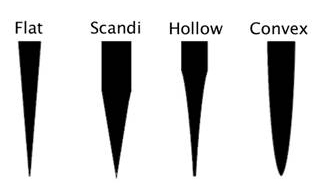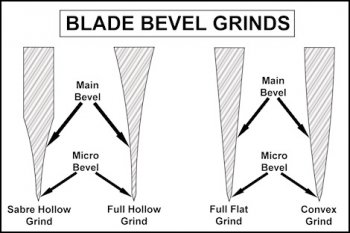These may have all been answered to your satisfaction, but I'll put my .02 in:
What is and why is a slack belt used?
Slack belt is where you don't have anything backing (or behind) your belt, such as a flat platen, or a contact wheel. This gives "slack" in your belt and allows it to conform to inside and outside curves. It also typically provides more surface contact with the belt, as it is conforming to your piece, rather than just grinding on the highest/closest point.
You typically use slack belt grinding when you want to contour or round something over. J-flex belts are great for slack belting, as they are much thinner and tend to conform better. I use slack belt when shaping handles, rounding spines, and convexing edges. Keep in mind that when using thinner, more flexible belts, things will grind differently than if using a platen, contact wheel, or even just a heavier belt. For example: handle pins are harder than the average handle material, and will grind much more slowly, thus making them feel "proud" of the immediately surrounding material. Take extra care when grinding around pins to make sure that the surrounding surface remains flush and even. Make sense?
What are the various grinds and what are they used for?
IMO, grinds often boil down to preference, though geometry can and does play a role in efficiency and ultimate use.
Thinness at the edge, as well as edge bevel is ultimately the deciding factor of how well the knife works in any case, IMO.
Convex is great for chopping and adds strength behind the edge, comparatively speaking. Full Flat grinds is good for slicing, Hollow can be a good slicer, but it's main advantage is that you can sharpen it more (or remove more metal from the edge)before the edge starts to get thicker. Scandi has no secondary bevel and is arguably easier to sharpen/touch up.
Many different people prefer many different grinds and geometries. You can argue the pros and cons of each until the cows come home...
If you seal a blade in SS foil do you quench it in the foil or remove the foil, thus cooling the metal inside?
Foil wrap is typically used on "air hardening" blades. Most applications allow you to leave the blade in the foil while you press both the knife and foil between quench plates. Once the knife cools, you can remove it. The foil is merely one way of eliminating oxygen from high temperature heat treatment processes, where the amount of heat would destroy the blade if oxygen were present.
Can you 'stabilize' a piece of leather for a set of scales?
You can, but as Mr. Svinarich already stated, oil is an adequate sealant/protected, and still allows you to maintain the "feel" of leather.
What is a good progression of belts when starting a new blade?
There are probalby as many opinions/techniques on this as there are belts to choose from. I usually start with a 60 to 80 grit for roughing, than take it to 120 to 220 for heat treat. Final finishing might be done anywhere from 220 to 1000 grit.
Just make sure that with every progression of grit, that you are removing all off the scratches from the previous grit, because the closer you get to 1000, the long it will take to remove that last scratch from the 220.
Progression ultimately depends on how quickly would want to remove metal, vs. how shiny you want your final finish to be.
I'd say that for most "users", 400 grit is more than adequate.
Best way to wrap a handle with paracord?
Tighter is usually better. You don't want it to fall off down the road. Sealing the paracord with epoxy or superglue can prevent that. As for whether to do a straight wrap, double wrap, or a decorative wrap, that's all up to you (or the customer).
When a handle is wrapped in paracord do you seal or coat it, and with what?
Epoxy makes a good sealant. Whether you seal it or not is up to you (or the customer).
If steels are stacked and welded to make Damascus how do you get the flux inside?
You add flux WHILE you are welding pieces/surfaces together.
What is the easiest grind for a noob to master?
If you can master any grind, then you are no longer a noob...

A lot of guys start with flat grinds and have trouble with hollows after. I started with hollows and had trouble with flats for a while.
Ultimately, I think it really just depends on which grind to start with, and how much time you dedicate to learning it.
If using jigs, flats are probably easier to facilitate, though I will add that I think everyone should be able to freehand grind.
All that said, how quickly you learn one grind or the other really does vary from person to person. Just pick one you like, and start practicing!



